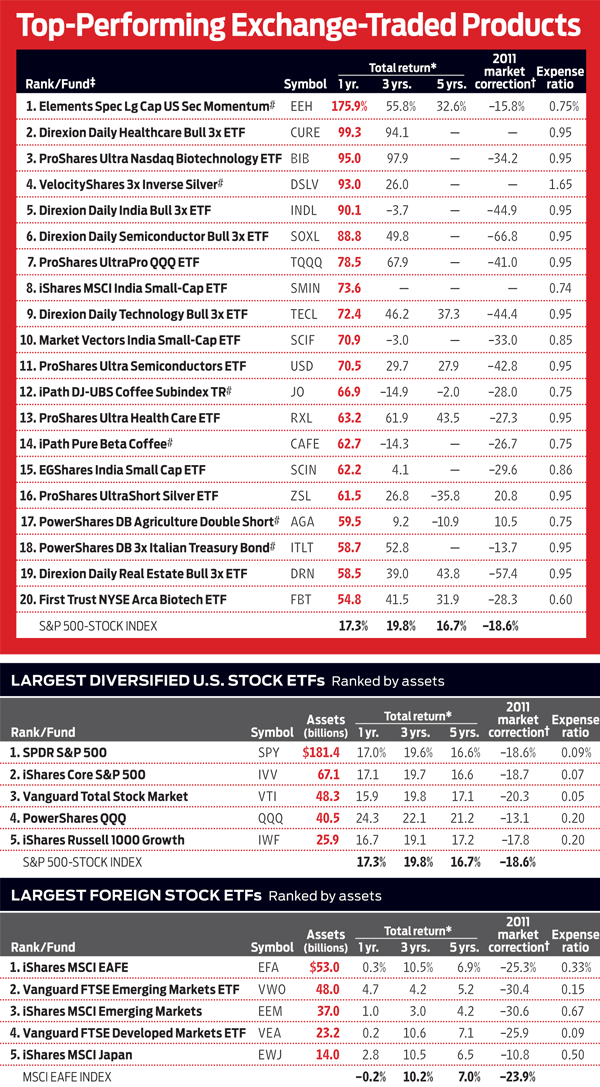The 20 Top-Performing ETFs -- and Why You Shouldn't Buy Them
The winners list is filled with all sorts of funds that most of us have no business owning.

The table below contains a roster of top-performing exchange-traded products of all stripes. For reasons that will become clear in a moment, those returns should tell you to run away.
The winners are as exotic a crew of exchange-traded funds and exchange-traded notes as you’re ever likely to find, from leveraged funds that seek to triple the return of an index to those that bet against the price of silver. The top performer, the Elements Spectrum note, follows a complex strategy based on the daily results of the 10 sectors of Standard & Poor’s 500-stock index.
What’s wrong with buying a red-hot ETF? For starters, in most cases you’ll have to make a call on a narrow sector or market. Do you really have special insights into small Indian companies or the coffee market? Okay, place your bets. Second, the volatility of these funds is off the charts. For example, Direxion Daily Semiconductor Bull 3x ETF dived 43% during the market’s 7% decline in September and October.

Sign up for Kiplinger’s Free E-Newsletters
Profit and prosper with the best of expert advice on investing, taxes, retirement, personal finance and more - straight to your e-mail.
Profit and prosper with the best of expert advice - straight to your e-mail.
Finally, leveraged ETFs can only promise to meet their goals on a daily basis. Because of the peculiarities of daily compounding, the results can be surprising. In 2011, for example, when the S&P 500 earned 2.1%, Direxion Daily S&P 500 Bull 3x Shares lost 14.9%. In short, it’s best to leave these so-called winners to professionals—and gamblers.

*Assumes reinvestment of all dividends and capital gains; three and five year returns are annualized. # Exchange-traded note. Expense ratio is the percentage of assets claimed annually for operating a fund. Source: Morningstar Inc.
Get Kiplinger Today newsletter — free
Profit and prosper with the best of Kiplinger's advice on investing, taxes, retirement, personal finance and much more. Delivered daily. Enter your email in the box and click Sign Me Up.

-
 Two Don'ts and Four Dos During Trump's Trade War
Two Don'ts and Four Dos During Trump's Trade WarThe financial rules have changed now that tariffs have disrupted the markets and created economic uncertainty. What can you do? (And what shouldn't you do?)
By Maggie Kulyk, CRPC®, CSRIC™
-
 I'm Single, With No Kids: Why Do I Need an Estate Plan?
I'm Single, With No Kids: Why Do I Need an Estate Plan?Unless you have a plan in place, guess who might be making all the decisions about your prized possessions, or even your health care: a court.
By Cynthia Pruemm, Investment Adviser Representative
-
 The 5 Best Actively Managed Fidelity Funds to Buy Now
The 5 Best Actively Managed Fidelity Funds to Buy Nowmutual funds In a stock picker's market, it's sometimes best to leave the driving to the pros. These Fidelity funds provide investors solid active management at low costs.
By Kent Thune
-
 The 12 Best Bear Market ETFs to Buy Now
The 12 Best Bear Market ETFs to Buy NowETFs Investors who are fearful about the more uncertainty in the new year can find plenty of protection among these bear market ETFs.
By Kyle Woodley
-
 Don't Give Up on the Eurozone
Don't Give Up on the Eurozonemutual funds As Europe’s economy (and stock markets) wobble, Janus Henderson European Focus Fund (HFETX) keeps its footing with a focus on large Europe-based multinationals.
By Rivan V. Stinson
-
 Vanguard Global ESG Select Stock Profits from ESG Leaders
Vanguard Global ESG Select Stock Profits from ESG Leadersmutual funds Vanguard Global ESG Select Stock (VEIGX) favors firms with high standards for their businesses.
By Rivan V. Stinson
-
 Kip ETF 20: What's In, What's Out and Why
Kip ETF 20: What's In, What's Out and WhyKip ETF 20 The broad market has taken a major hit so far in 2022, sparking some tactical changes to Kiplinger's lineup of the best low-cost ETFs.
By Nellie S. Huang
-
 ETFs Are Now Mainstream. Here's Why They're So Appealing.
ETFs Are Now Mainstream. Here's Why They're So Appealing.Investing for Income ETFs offer investors broad diversification to their portfolios and at low costs to boot.
By Nellie S. Huang
-
 Do You Have Gun Stocks in Your Funds?
Do You Have Gun Stocks in Your Funds?ESG Investors looking to make changes amid gun violence can easily divest from gun stocks ... though it's trickier if they own them through funds.
By Ellen Kennedy
-
 How to Choose a Mutual Fund
How to Choose a Mutual Fundmutual funds Investors wanting to build a portfolio will have no shortage of mutual funds at their disposal. And that's one of the biggest problems in choosing just one or two.
By Coryanne Hicks